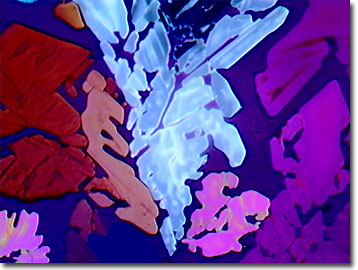Polarized Light Digital Image Gallery
Methylene Blue
A chemically basic dye, methylene blue is also known as tetramethyl thionin, and there are various grades used, including methylene blue chloride, which is preferred for biological work. The dye is easily oxidized and often contains azure B and methylene violet, depending on the manufacturer.

View a second image of methylene blue.
With 16 carbons, 18 hydrogens, 3 nitrogens, 1 sulfur, and 1 chlorine atom in each molecule, the molecular weight of methylene blue is 319.86 and its absorption maxima, if pure, reside at 668 and 609 nanometers. Actual staining material labeled as methylene blue is either aged or akalinized, and the pure substance appears to be a rather poor histological stain. As a green powder, the melting point is 190 degrees Celsius. To an organic chemist, methylene blue is better known as 3,7-bis-(dimethylamino)-phenothiazin-5-ium chloride and to some histologists as Swiss blue.
Widely utilized as a nuclear stain (both DNA and RNA) and as a stain in bacteriology, methylene blue is usually prepared as the double zinc chloride formulation, which is less soluble and easier to isolate. However, this form of the dye is toxic, so medicinal preparations and compounds used with live biological specimens should be zinc-free. The salt, methylene blue thiocyanate, is used as a redox indicator in the sanitary monitoring of milk.
Sometimes marketed under the trade names urolene blue and aniline violet, chemists also refer to the dye compound as methylthionine chloride or tetramethylthionine chloride. In health care, pharmaceutical-grade methylene blue is prescribed to treat methemoglobinemia, a condition also referred to as "blue baby syndrome" where the blood cannot deliver oxygen where it is required in the body. Methemoglobinemia is a symptom sometimes exhibited by babies born in areas with very high levels of nitrate pollution in the drinking water supply, particularly in rural areas that are dependent on well water and where chemical fertilizers are widely applied. Similarly, methylene blue is indicated as a remedy for cyanide poisoning. Methylene blue is sometimes used in surgey as a dye for parts of the body the medical team wishes to identify.
As a redox indicator, methylene blue solution is colorless until it is oxidized and turns blue. Glucose, a reducing agent, when added in alkaline solution, reduces methylene blue to its colorless form once again. Veterinarians utilize methylene blue also as an antiseptic. New research reveals that methylene blue can be activated by light to an excited state, which can then activate oxygen, creating oxidizing radicals. These radicals can initiate cross-linking of amino acid residues on proteins, so that methylene blue may be useful for the photochemical welding of tissues.
Contributing Authors
Omar Alvarado, Thomas J. Fellers and Michael W. Davidson - National High Magnetic Field Laboratory, 1800 East Paul Dirac Dr., The Florida State University, Tallahassee, Florida, 32310.
BACK TO THE POLARIZED LIGHT IMAGE GALLERY
BACK TO THE DIGITAL IMAGE GALLERIES
Questions or comments? Send us an email.
© 1995-2025 by Michael W. Davidson and The Florida State University. All Rights Reserved. No images, graphics, software, scripts, or applets may be reproduced or used in any manner without permission from the copyright holders. Use of this website means you agree to all of the Legal Terms and Conditions set forth by the owners.
This website is maintained by our
Graphics & Web Programming Team
in collaboration with Optical Microscopy at the
National High Magnetic Field Laboratory.
Last Modification Friday, Nov 13, 2015 at 01:19 PM
Access Count Since September 17, 2002: 10169
Visit the website of our partner in introductory microscopy education:
|
|
